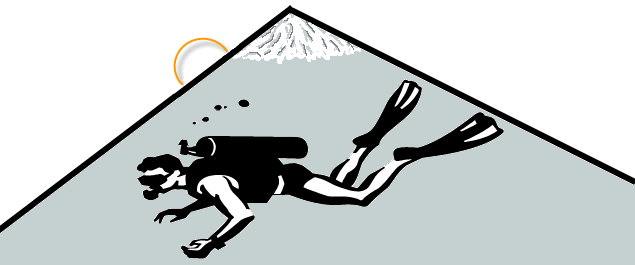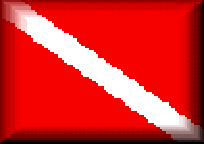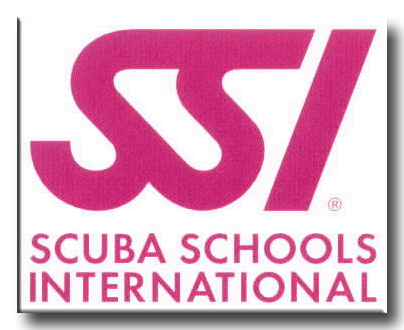
COZUMEL
Get Your Dream's Worth -- Diving's Biggest Bargain

|

|
OVERVIEW of COZUMEL
|
Diving in Cozumel The Mexican island of Cozumel was a sleepy little fishing community until 1961, when a Frenchman by the name of Jacques Cousteau declared it one of the most beautiful scuba diving areas of the world. Since that time, Cozumel has become a mecca for divers, and has declared the southern reef area as an underwater National Marine Park to protect the delicate balance of its dazzling coral reefs and abundant variety of tropical fish. The underwater wildlife is absolutely amazing here: flounder, grouper, stingrays, turtles and hundreds of colorful, tropical fish dart around the coral reefs. Visibility ranges from 60 ft. to 200 ft., depending on the season and water conditions. Most diving in Cozumel is drift diving, where divers (accompanied by their dive guides) are dropped off by the boat up current at the start of the dive, and are carried along the reef by the current. As divers complete their underwater tour, they are picked up at the end of the dive by the boat... making navigation easy. Shore diving is available for buoyancy checks and refreshers, but to experience the true coral reefs, divers should head out on the boat dives. The island's diving association assesses a fee of $2.00 per dive, with the proceeds going to protect the reef. A separate daily fee (about $1.00) is also assessed to support the island's recompression chamber, which any diver can then use at no additional charge. This fee is waived for divers having DAN membership. There are four recompression chambers located in Cozumel, some staffed 24 hrs. a day. Besides diving, Cozumel is also world renown for its dazzling white sandy beaches and the remarkable clarity of the multi-hued turquoise-blue Caribbean ocean in which it rests. The climate is subtropical & the people native to Cozumel are of Mayan descent. Passport and/or Visa Requirements A valid passport is required. Other required items include a return ticket, confirmation of hotel reservation, and another form of picture ID required. EXIT REQUIREMENTS: There is a departure tax of $20.00 pp US payable at the airport upon departure in cash. Language & Currency Spanish is the official language but English is spoken in establishments catering to tourists. The Mexican peso is the official currency of Cozumel, however, the US dollar is widely accepted. The island has several banks and “casas de cambio” which can exchange money, as well as ATM machines. Most places accept dollars, but you usually get a better deal paying in pesos. The Peso is divided into 100 centavos. Coins from 5, 10, 20 and 50 centavos, to 1, 2, 5, 10 and 20 pesos. Notes from 20, 50, 100 and 200 to 500 pesos. Location and Size Cozumel is Mexico's largest island, sitting just 12 miles off the coast of the Yucatan Peninsula. Its highest elevation is 1030 feet above sea level with average annual rainfall of 47.5 inches. The average January Temperature is 71 degrees F, while the average July Temperature is 82 degrees F. Cozumel is 43 miles south of Cancún and 12 miles southeast of Playa del Carmen. Ferries take passengers between Playa del Carmen on the mainland side to Cozumel island in about 35 min. Cozumel measures 28 miles long & 10 miles wide. The capital city is San Miguel. |
Culture and Customs "Carnaval de Cozumel” is one of the most awaited and colorful celebrations on the Island, usually held in February, depending on the date of Easter. Carnival is a celebration in which the whole town participates with people of all ages in costumed dances, parades, parties filling up bars and restaurants. This is where the streets of downtown close for the parades and the party never ends. A definite MUST SEE while in Cozumel. El Cedral or Santa Cruz is a 150 year old celebration held in Cozumel during the first week of May. A fair celebrates a promise made by a survivor during the Yucatan War of the Casts, who promised that his descendants would honor the Cruz (Cross) for all of their lives. "Day of the Dead" is a holiday of remembrance, held on November 1st. This is where people offer respect to their deceased family members and friends by going to the cemetery and offering food and flowers to their loved ones. Very elaborate altars are prepared and taken to the cemetery along with artwork, pictures and candles. Electricity, Telephone and Internet Access Electricity is 110 volts, 60 cycles, same as in the U.S., so converters are not necessary. Mexico has a modern, fully and reliable digital telecommunication system. The Country Dialing Code is 52, while the area code for Cozumel is 987. International Direct Dialing is available from your hotel rooms. Several cybercafés are in and about the main square. Common operating hours are Monday through Saturday from 10am to 8pm. Water Quality Generally no problems, especially at restaurants at the tourist resorts, but be cautious when buying food/fruits from street vendors. Drink only bottled water, and use bottled water for oral hygiene Time Mexico spans three different time zones. Cozumel is on central time, putting them in the same time zone as Chicago, or 6 hours behind Greenwich mean time. Two of Mexico's time zones observe daylight saving time during the summer months; during that time clocks are advanced by 1 hour. History, Art, and Culture The Mayans were the first to occupy Cozumel settling on the island in the 1st millennium A.D. They considered the island to be sacred and dedicated it to Ix Chel, the Moon Goddess. Many temples were built here and were places of pilgrimage, especially by women seeking fertility. The name Cozumel comes from the Mayan cuzamil which means land of the swallows. At the start of the 16th century the Spanish came to Cozumel but by the end of the century the island’s population dwindled to only a few hundred due to fighting and diseases brought by the Spanish. The island remained mostly deserted until the 17th century when it became a popular base for pirates, including the famous Henry Morgan. In the late 19th century the island became settled again and grew into an important hub for distributing chicle (natural chewing gum) from the mainland. However, now, tourism is the island's main industry. Population Approx. 90,000 |



